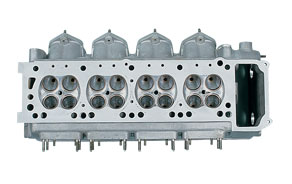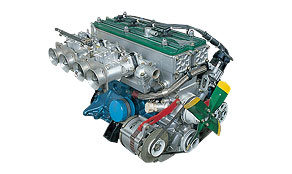 |


 The LZ head featured a narrow valve angle and shallow pent-roof combustion chamber.
The LZ head featured a narrow valve angle and shallow pent-roof combustion chamber.
LZ achieves debut win in ’73 Japan Grand Prix
Soon it was time for the 1973 Japan GP: May 3. The Nissan works team entered 9 Sunny Excellents equipped with the new LZ14 engine. The drivers were (1) K. Takahashi, (2) H. Kitano, (3) K. Tohira, (5) S. Suzuki, (6) S. Tsujimoto, (7) T. Teranishi, (8) T. Shinohara, (9) H. Yanagida, and (10) H. Kubota.
The race was dominated by Kitano in car No.2 (pole position, with a lead of 1 minute 31.17 seconds). Coming in 2nd and 3rd were also works Excellents. The LZ engine thus had managed a magnificent debut, taking the top three places with its unrivalled performance.
The LZ14 used in the 1973 Japan GP had a displacement of 1,598cc (bored up by 4.8mm to 87.8mm). Prepared to EGI specifications, maximum power was 200PS/9,400rpm, and maximum torque was 17.0kgm/6,800rpm. Instead of cast iron, the cylinder head was made from aluminum alloy, and the 16 intake and exhaust valves from titanium. It also featured a narrow valve angle of 34 degrees, an ideally shallow pent roof to the combustion chamber, and a compression ratio of 11.5~12.0. Each of the light-alloy pistons had a flat head with a deep valve recess, while the con rods were made from forged steel with mirror-ground edges. All the con rod/piston assemblies were carefully balanced to the same weight.
An innovative mechanism, using both gears and chains, was adopted to drive the camshaft: on the crank end was a 4-stage gear drive, while on the cam end there was a double roller chain. A special feature of the LZ engine was the thin housing for the cam drive. The head cover was rounded, unlike the flat type that was later used; it was finished with black crystal paint.
What made the development of the LZ engine special was the fact that, in a very short time, Nissan created a racing engine compact enough to fit into the engine room of a production vehicle, which offers little space, despite the fact that it had a narrow-angle valve layout (which tends to increase the overall height of an engine). |
 |




